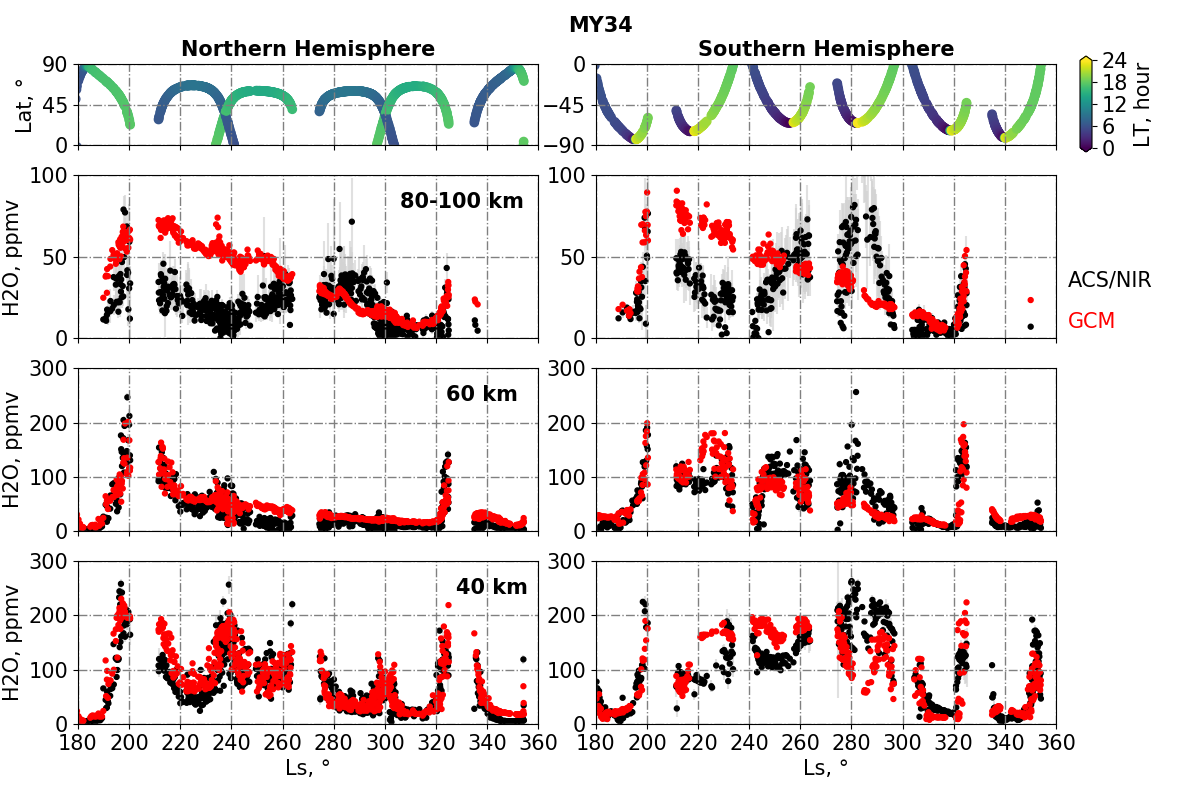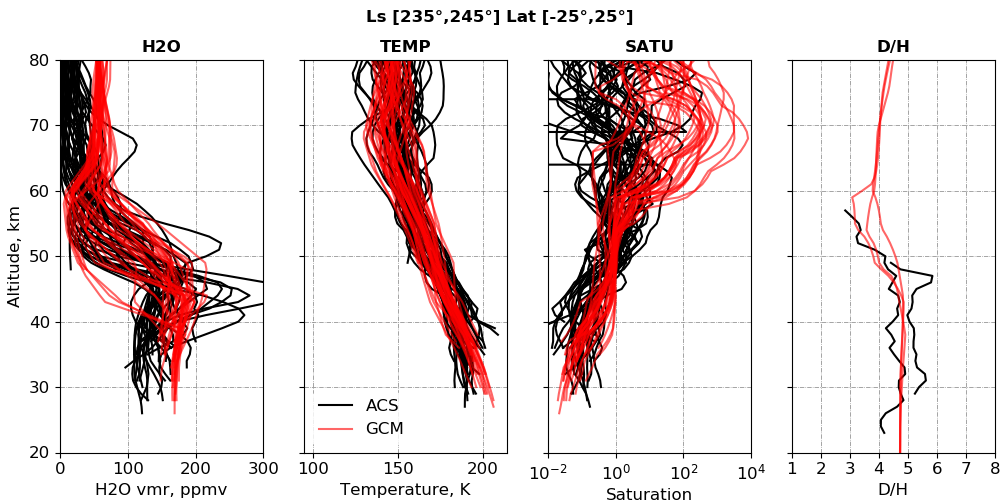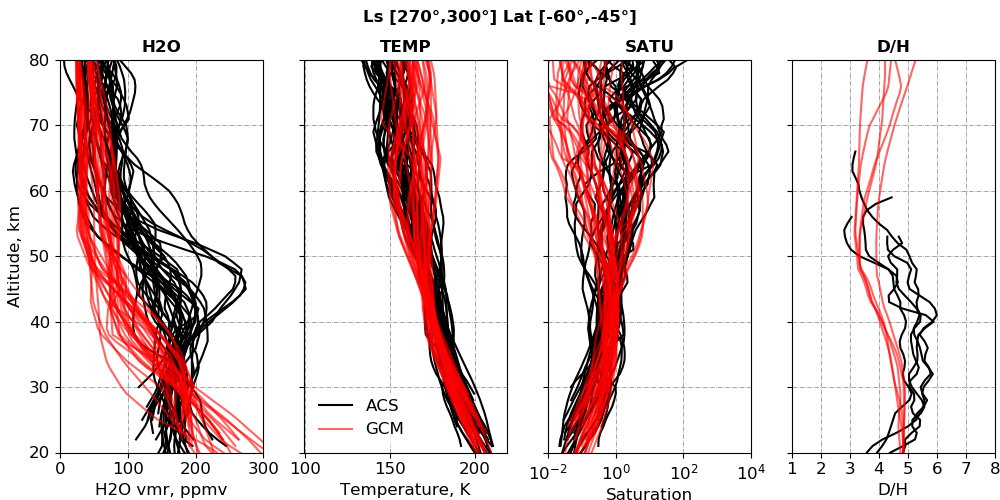Modeling the Martian HDO cycle with a Global Climate Model during the “dusty” season
- 1CNRS, Laboratoire ATmosphères, Milieux, Observations Spatiales, Paris, Guyancourt, France (margaux.vals@lmd.jussieu.fr)
- 2Instituto de Astrofisica de Andalucia-CSIC, Granada, Spain
- 3Space Research Institute (IKI), Moscow, Russia
- 4AOPP, Oxford University, Oxford, UK
- 5School of Physical Sciences, The Open University, Milton Keynes, UK
- 6Laboratoire de Météorologie Dynamique, Paris, France
Abstract
The D/H ratio measured in the Martian atmosphere gives an estimation of the planet’s water escape rate. We present here a global circulation model including the water isotope HDO and the main physical processes of fractionation. Modeling the D/H cycle accompanies the recent measurements from the ACS spectrometer onboard the orbiter TGO. The comparison between the model outputs and the TGO/ACS observations reveal some discrepancies, in particular during the second half of the martian year, when the escape is supposed to be the most efficient. The present work aims at studying these main differences.
Introduction
The high value of the Martian D/H ratio, derived from the HDO/H2O abundance ratio, in comparison to that of the Earth’s oceans[1],[2],[3],[4], is an indicator of the large escape of water from Mars over time. Apart from the mass difference between both isotopes, the differential escape of H and D comes from the preferential photolysis of H2O over HDO[5] and the preferential condensation of HDO over H2O [6],[7],[8]. The NOMAD and ACS instruments onboard ExoMars Trace Gas Orbiter (TGO) have recently provided unprecedented observations of vertical variations in HDO abundance and D/H ratio in the martian atmosphere [9],[10],[11],[12], motivating model development [13],[14]. In particular, TGO data cover the second half (“dusty season”) of martian year (MY) 34, which includes a Global Dust Storm (GDS) (Ls 180°-230°) and a regional dust storm (Ls 315°-330°). These dust events have been proven to be of particular importance in the hydrogen escape inventory [12],[15],[16],[17],[18].
HDO modeling
The D/H ratio measured in the Martian atmosphere gives an estimation of the planet’s water escape rate. We present here a global circulation model including the water isotope HDO and the main physical processes of fractionation. Modeling the D/H cycle accompanies the recent measurements from the ACS spectrometer onboard the orbiter TGO. The comparison between the model outputs and the TGO/ACS observations reveal some discrepancies, in particular during the second half of the martian year, when the escape is supposed to be the most efficient. The present work aims at studying these main differences. Based on Montmessin et al. 2005[19], Rossi et al. 2021[13] have introduced the HDO cycle in the Mars Planetary Climate Model (Mars PCM), formely known as the LMD Mars Global Climate Model[20]. Vals et al. 2022[21] have recently adapted these implementations to the complete representation of the water ice clouds, including the radiative effect of clouds[22] and microphysics, the latter allowing the modeling of supersaturation[23]. The effect of kinetics in the fractionation by condensation has also been included, as has the photodissociation of HDO and the photochemical reactions of the deuterated species [24],[25],[26]. Rossi et al. 2022[27] have used the improved model to compare with TGO/ACS/MIR retrievals of D/H profiles[28] and revealed some discrepancies, which account for the challenge of reproducing the D/H cycle, depending on key components of the Martian atmosphere such as the water and dust cycles.
Preliminary results
By comparing the simulations and the observations, we particularly notice an overestimation by the model of water vapor above ∼60 km occuring near the GDS in MY34, and an underestimation near perihelion in the southern hemisphere (see Figure 1). The difference in water vapor vertical distribution has a direct impact on the D/H profiles (see Figures 2 and 3). In this work, we want to analyse these differences to eventually propose some model improvements. Further comparisons and results for MY34 and 35 will be shown at the conference.

Figure 1: Water vapor volume mixing ratio in ppmv as measured by TGO/ACS/NIR[16] (black) and as computed by the model (red) at different altitude ranges.

Figure 2: Water vapor volume mixing ratio, temperature and saturation as measured by TGO/ACS/NIR[16], and D/H profiles as measured by TGO/ACS/MIR[28] (black) and as computed by the model (red) during MY34 between solar longitudes 235°, 245° and latitudes -25°N, 25°N.

Figure 3: Same layout as Figure 2 between solar longitudes 270°, 300° and latitudes -60°N, 45° N.
References
[1] Owen et al.: Science, 240 (4860), 1767-1770, 1988
[2] Encrenaz et al.: A&A, 612 , A112, 2018.
[3] Krasnopolsky: Icarus, 257 , 377 - 386, 2015
[4] Villanueva et al.: Science, 348 (6231), 218–221, 2015.
[5] Cheng et al.: Geophysical Research Letters, 26 (24), 3657-3660, 1999
[6] Krasnopolsky: Icarus, (2), 597-602, 2000.
[7] Fouchet et al.: Icarus, 144 , 114-123, 2000.
[8] Bertaux et al.: Journal of Geophysical Research: Planets, 106 (E12), 32879-32884, 2001.
[9] Vandaele et al.: Space Science Reviews, 214 (5), 80, 2018.
[10] Vandaele et al.: Nature, 568 (7753), 521-525, 2019.
[11] Korablev et al.: Space Science Reviews, 214 , 7, 2018.
[12] Korablev et al.: Nature, 568 (7753),517-520, 2019.
[13] Rossi et al.: grl , 48 (7), e90962, 2021.
[14] Daerden et al.: Journal of Geophysical Research (Planets), 127 (2), e07079, 2022.
[15] Aoki et al.: Journal of Geophysical Research (Planets), 124 (12), 3482-3497, 2019.
[16] Fedorova et al.: Science, 367 (6475), 297-300, 2020.
[17] Neary et al.: Geophysical Research Letters, 47 (7), e84354, 2020.
[18] Chaffin et al.: Nature Astronomy, 5 , 1036-1042, 2021.
[19] Montmessin et al.: Journal of Geophysical Research, 2005.
[20] Forget et al.: JGR, 104:24,155–24,176, 1999.
[21] Vals et al.: Journal of Geophysical Research (Planets), under revision, 2022.
[22] Madeleine et al. : Geophys. Res. Lett., 39 , 23202, 2012.
[23] Navarro et al.: Journal of Geophysical Research (Planets), 2014.
[24] Lefèvre et al.: Journal of Geophysical Research (Planets), 126 (4), 2021.
[25] Cheng et al.: Journal of Chemical Physics, 120 (1), 224-229, 2004.
[26] Chung et al.: Nuclear Instruments and Methods in Physics Research A, 467 (2002), 1572-1576, 2001.
[27] Rossi et al.: Journal of Geophysical Research (Planets), under revision, 2022.
[28] Alday et al.: Nature Astronomy, 5, 943-950, 2021.
How to cite: Vals, M., Montmessin, F., Rossi, L., Braude, A., Lefèvre, F., Gonzalez-Galindo, F., Chaufray, J.-Y., Fedorova, A., Alday, J., Forget, F., Millour, E., Korablev, O., Trokhimovskiy, A., and Shakun, A.: Modeling the Martian HDO cycle with a Global Climate Model during the “dusty” season, Europlanet Science Congress 2022, Granada, Spain, 18–23 Sep 2022, EPSC2022-451, https://doi.org/10.5194/epsc2022-451, 2022.

